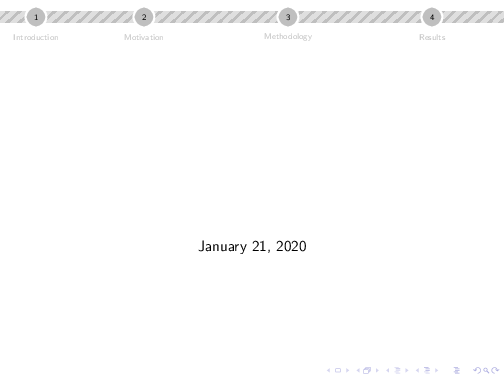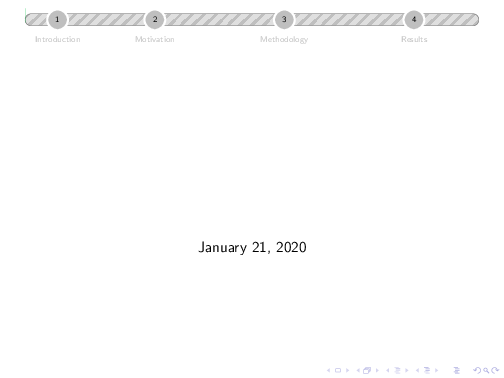One can modify https://topanswers.xyz/tex?q=587#a640 a bit to add the section names and numbers:
```
\documentclass[xcolor={rgb}]{beamer}
\usepackage{totcount}
\newtotcounter{mysec}
\AtBeginSection{\addtocounter{mysec}{1}\label{mysec:\themysec}}
\newcounter{foo}
\usepackage{refcount}
\usepackage{tikz}
\usetikzlibrary{patterns.meta}
\setbeamertemplate{headline}{%
\vskip4pt
\begin{tikzpicture}
\path[preaction={fill, lightgray},pattern={Lines[angle=45,line width=3pt,distance=6pt]},pattern color=lightgray!50] (0,0) rectangle (\paperwidth,0.3);
\path[preaction={fill, green!50!teal},pattern={Lines[angle=45,line width=3pt,distance=6pt]},pattern color=green!50!teal!50] (0,0) rectangle ({(\thepage-1)/(\insertdocumentendpage-1)*\paperwidth},0.3);
\ifnum\thesection>0
\path[preaction={fill, cyan!50!blue},pattern={Lines[angle=45,line width=3pt,distance=6pt]},pattern color=cyan!50!blue!50] (0,0) rectangle ({(\insertsectionstartpage-1)/(\insertdocumentendpage-1)*\paperwidth},0.3);
\fi
\foreach \x in {1,...,\totvalue{mysec}}{%
\setcounterpageref{foo}{mysec:\x}
\colorlet{seccol}{green!50!teal}
\ifnum\thesection=\x
\colorlet{seccol}{green!50!teal}
\else
\ifnum\thesection<\x
\colorlet{seccol}{lightgray}
\else
\colorlet{seccol}{cyan!50!blue}
\fi
\fi
\node[circle,fill=seccol,draw=white,line width=1.5pt,minimum size=15pt] at ({(\thefoo-1)/(\insertdocumentendpage-1)*\paperwidth},0.15) {\x};
\node[seccol] at ({(\thefoo-1)/(\insertdocumentendpage-1)*\paperwidth},-0.35) {\nameref{mysec:\x}};
}
\end{tikzpicture}%
}
\begin{document}
\begin{frame}
\titlepage
\end{frame}
\section{Introduction}
\begin{frame}
\end{frame}
\begin{frame}
\end{frame}
\begin{frame}
\end{frame}
\section{Motivation}
\begin{frame}
\end{frame}
\begin{frame}
\end{frame}
\begin{frame}
\end{frame}
\begin{frame}
\end{frame}
\section{Methodology}
\begin{frame}
\end{frame}
\begin{frame}
\end{frame}
\begin{frame}
\end{frame}
\begin{frame}
\end{frame}
\section{Results}
\begin{frame}
\end{frame}
\begin{frame}
\end{frame}
\begin{frame}
\end{frame}
\end{document}
```

### Second version with rounded corners
```
\documentclass[xcolor={rgb}]{beamer}
\usepackage{totcount}
\newtotcounter{mysec}
\AtBeginSection{\addtocounter{mysec}{1}\label{mysec:\themysec}}
\newcounter{foo}
\usepackage{refcount}
\usepackage{tikz}
\usetikzlibrary{patterns.meta}
\usetikzlibrary{fadings,patterns,shadows}
\setbeamertemplate{headline}{%
\vskip6pt
\centering
\begin{tikzpicture}
\path[draw=gray,rounded corners,preaction={fill, lightgray},pattern={Lines[angle=45,line width=3pt,distance=6pt]},pattern color=lightgray!50] (0,0) rectangle (.9\paperwidth,0.3);
\path[rounded corners,preaction={fill, green!50!teal},pattern={Lines[angle=45,line width=3pt,distance=6pt]},pattern color=green!50!teal!50] (0,0) rectangle ({(\thepage-1)/(\insertdocumentendpage-1)*.9\paperwidth},0.3);
\ifnum\thesection>0
\path[rounded corners,preaction={fill, cyan!50!blue},pattern={Lines[angle=45,line width=3pt,distance=6pt]},pattern color=cyan!50!blue!50] (0,0) rectangle ({(\insertsectionstartpage-1)/(\insertdocumentendpage-1)*.9\paperwidth},0.3);
\fi
\foreach \x in {1,...,\totvalue{mysec}}{%
\setcounterpageref{foo}{mysec:\x}
\colorlet{seccol}{green!50!teal}
\ifnum\thesection=\x
\colorlet{seccol}{green!50!teal}
\else
\ifnum\thesection<\x
\colorlet{seccol}{lightgray}
\else
\colorlet{seccol}{cyan!50!blue}
\fi
\fi
\node[circle,fill=seccol,draw=white,line width=1.5pt,minimum size=15pt] at ({(\thefoo-1)/(\insertdocumentendpage-1)*.9\paperwidth},0.15) {\x};
\node[seccol] at ({(\thefoo-1)/(\insertdocumentendpage-1)*.9\paperwidth},-0.35) {\nameref{mysec:\x}};
}
\end{tikzpicture}%
\par%
}
\begin{document}
\begin{frame}
\titlepage
\end{frame}
\section{Introduction}
\begin{frame}
\end{frame}
\begin{frame}
\end{frame}
\begin{frame}
\end{frame}
\section{Motivation}
\begin{frame}
\end{frame}
\begin{frame}
\end{frame}
\begin{frame}
\end{frame}
\begin{frame}
\end{frame}
\section{Methodology}
\begin{frame}
\end{frame}
\begin{frame}
\end{frame}
\begin{frame}
\end{frame}
\begin{frame}
\end{frame}
\section{Results}
\begin{frame}
\end{frame}
\begin{frame}
\end{frame}
\begin{frame}
\end{frame}
\end{document}
```
